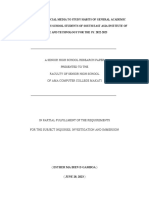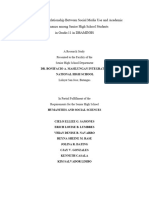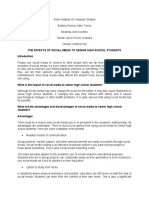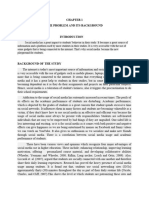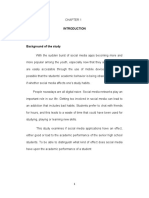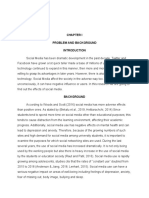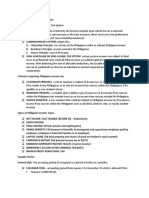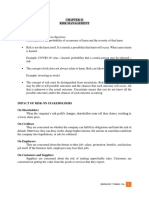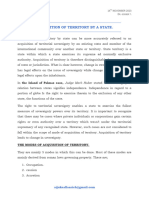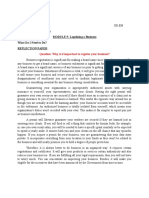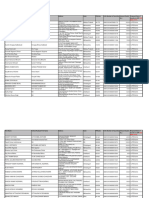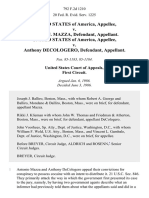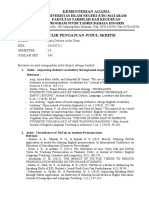Republic of the Philippines
Department of Education
REGION IV - A (CALABARZON)
SCHOOLS DIVISION OF IMUS CITY
GOV. JUANITO REYES REMULLA SENIOR HIGH SCHOOL
BRGY. TOCLONG II-B, IMUS CITY, CAVITE
“THE IMPACT OF SOCIAL MEDIA ON THE STUDY HABITS OF
SENIOR HIGH SCHOOL STUDENT IN GOV. JUANITO REYES
REMULLA SENIOR HIGH SCHOOL”
Submitted by:
Group Members:(11-ACACIA)
Kevin Samaniego
Leigh Gabrielle C. Secretario
Jonessa Cantiga
Marianne Mandi
Daniela Taray
Draven Dash Lopez
Mark Laurence Libunao
Benmark Jabulin
Analisa Aranduque
Jelycka Delgado
Submitted to:
Mantala, Reynalyn B.
� Chapter Ⅰ
THE PROBLEM AND ITS BACKGROUND
I. Introduction
Social media is a computer technology that facilitates the sharing of ideas, thoughts and
information through the creation of virtual networks and communities. Social media is online in
its structure and enables rapid transmission of electronic content. Content includes personal
information, documents, videos and photos. Users connect to social media on a computer, tablet
Or smartphone through web-based software or web applications, which often use it to send
messages. Social media platforms can be very distracting, causing students to spend more time
browsing channels instead of studying. This can reduce concentration and productivity during
study sessions.
With social media constantly available on smartphones and other devices, students can
procrastinate by engaging in social media instead of studying. This can lead to poor time
management and finishing tasks quickly. Excessive use of social media has been linked to
impaired cognitive abilities, including attention and concentration. This can negatively affect a
student’s ability to understand and retain information while studying. Many students use social
media late at night, which can disrupt their sleep patterns. Insufficient sleep negatively affects
cognitive function and academic performance.
Social media often portrays unrealistic standards of success and beauty, leading to
feelings of inadequacy and low self-esteem in students. This can affect their motivation to learn
and their overall mental well-being. While social media can provide a wealth of information, it
can also be overwhelming for students as they try to filter out content related to their studies.
This can lead to confusion and difficulty distinguishing between reliable sources and fake
information. However, it’s important to note that social media can also have positive effects on
study habits. For example, students can use platforms like YouTube, Facebook, Twitter,
�Linkedln, Instagram and educational forums to access supplemental learning materials and
connect with peers for collaborative studying.
II. Background of the Study
The benefits and of social media optimization exceed each other because it has an impact
on students’ academic achievement. Reference claim that social networking sites draw students’
attention before diverting it to unsuitable and non-educational activities, such as pointless chit-
chatting. Reference also pointed out that although social networks- which have grown to be
incredibly popular and well-known over the past few years- are undoubtedly a progression of
technology, they are especially dangerous for teenagers.
According to Anderson (2018) delves into the correlation between social media usage
and academic performance among senior high school students, utilizing survey data and
academic records to identify patterns and trends. Smith and Jones (2020) offer a qualitative
perspective on this topic through in-depth interviews and focus groups with senior high school
students, shedding light on how social media intricately influences study routines and habits.
Furthermore, Garcia et al. (2021) explored the impact of parental guidance and school
policies on regulating social media use among senior high school students, emphasizing the role
of external factors in shaping study habits. These authors contribute diverse insights, combining
quantitative and qualitative methods to provide a comprehensive understanding of the complex
relationship between social media and the study habits of senior high school students
III. Theoretical framework
A study examining how social media affects senior high school pupils at Gov. Juanito
Reyes Remulla SHS’s study habits might base its theoretical framework on a number of
important theories and ideas.
According to social cognitive theory, behavior, environment, and people all dynamically
interact and mutually , when learning takes place in a social environment. Social context and
�individual factors influence and influence social media use.The idea of media multitasking and
cognitive control stems from the fact that, for example, the use of social media during study
periods can affect cognitive functioning. Control functions, such as the ability to analyze external
information and switch between tasks.
Technological determinism: This is the idea that social media and other forms of
technology influence how people think, feel, and behave in society and how society functions. .
It can be used to study the impact of social media on learning habits.
The concept of uses and gratifications helps us understand why students use social media
and what needs it fulfills for them. This can help determine if and how these uses promote or
hinder learning habits.
Distraction-conflict idea: According to this idea, performing an important activity (like
studying) can interfere with a competing task (like browsing social media). Create an attentional
conflict that can interfere with the main task.(2023-2024).
Ⅳ. Conceptual framework
Being a teenager student most of the time using social media is the most comfortable way
to forget the stressful task. It influences their adults, and teenager. The researcher used the
alternating flow to show group information or sequential step in a task, process it emphasizes the
interaction or relationships among the groups of information.
� INPUT PROCESS OUTPUT
-Effects of low grades -Interview -The impact of social
-Academic stress leads -Questionnare media on the study habits
to feelings of decreased
wellbeing and an
increased likelihood of
developing anxiety or
depression.
-Effect an research
lesson in online
V. Statement of the Problem
This study aims to determine the impact of social media on the study habits of senior high school
student in Gov. Juanito Reyes Remulla Senior High School the researchers will seek answers to
the following problems:
1. What are the negative and positive effects of social media on students’
study habits?.
2. How can we effectively lessen the impact of social media on senior high
school students?
3. What is the main impact of social media on the study habits of
respondents?
Ⅵ. Scope and limitations
This research was conducted to determine what would the impact of social media to the students.
This study will help the students/parents to understand the dangers or the effects that have in
using social media sites, and also there has an advantage using some social media that helps the
students in their study. Interview 50 students in Gov. Juanito Reyes Remulla on how social
media affects their study habits.
�General Purpose: To discuss and develop an understanding of the dangers that student will face
when using social media and impact of social media on study habits. Population: Student of Gov.
Juanito Reyes Remulla Senior High School.
Ⅶ. Significance of the Study
The findings of this research will benefit the following:
Students
Understanding the impact of social media on their learning habits can help students make
informed decisions about their use of technology. They can learn to better manage their time,
mix and balance social media and academic responsibilities, which can improve academic
performance.
Teachers
Knowledge of the effects of social media can help teachers adapt their teaching methods
and assignments to meet students’ digital disabilities. They can also incorporate social media into
their teaching strategies to engage students and create more interactive learning experiences.
School
Schools can use the results to develop policies and programs that promote responsible use
of social media by students. They can also provide resources and support for students to
effectively manage their online activities while focusing on their studies.
Future Researchers
The study can inform future research on this topic, allowing researchers to use existing
knowledge and explore new ways of relating the impact of social media to education.
Ⅷ. Definition of terms
�Social Media
Social media are interactive technologies that facilitate the creation, sharing, and aggregation of
content, ideas, interests, and other forms of expression through virtual communities and
networks. Social media refers to new forms of media that involve interactive participation.
YouTube
YouTube is popular video sharing websites where registered users can upload and share
videos with anyone able to access the site. These videos can also be embedded and shared on the
other site.YouTube was developed by former PayPal employees in 2005 and was acquired by
Google in 2006. It has had a profound impact on media and advertising.
Facebook
Facebook is a social networking site that makes it easy for you to connect and share with
family and friends online. Originally designed for college students, Facebook was created in
2004 by Mark Zuckerberg while he was enrolled at Harvard University.
Instagram
Instagram is an photo and video sharing social networking service owned by Meta
Platforms.OIt allows users to upload media that can be edited with filters, be organized by
hashtag, and be associated with a location via geographical tagging. Posts can be shared publicly
or with preapproved followers.
Linkedln
LinkedIn is a business and employment-focused social media platform that works
through websites and mobile apps. It was launched on May 5, 2003 by Reid Hoffman and Eric
Ly. Since December 2016, LinkedIn has been a wholly owned subsidiary of Microsoft.
Twitter
Twitter is a free social networking site where users broadcast short posts known as
tweets. These tweets can contain text, videos, photos or links. To access Twitter, users need an
internet connection or smart phone to use the app or website, Twitter.com.
Web Application
�A web application is application software that is accessed using a web browser. Web
applications are delivered on the World Wide Web to users with an active network connection.
Single-page and progressive are two approaches for a website to seem more like a native app.
SmartPhone
A mobile phone that performs many of the functions of a computer, typically having a
touchscreen interface, internet access, and an operating system capable of running downloaded
applications.
Virtual Network
A virtual network is a network where all devices, servers, virtual machines, and data centers that
are connected are done so through software and wireless technology. This allows the reach of the
network to be expanded as far as it needs to for peak efficiency, in addition to numerous other
benefits.
Social Networking Sites
Social networking sites (SNSs) are virtual communities where users can create individual public
profiles, interact with real-life friends, and meet other people based on shared interests.

















